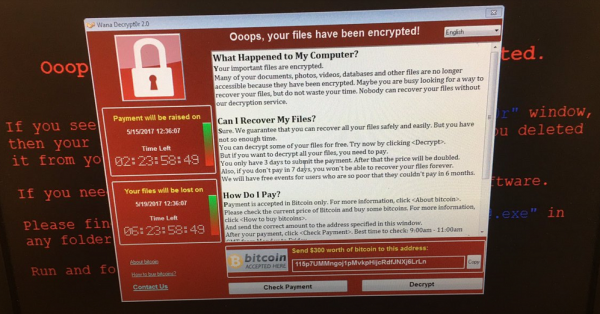WannaCrypt is a virus that encrypts user data and changes the extension of infected files. For example, the format of the Windows shortcut is EXE. If the file is corrupted, you will notice that the EXE extension will change to WNCRY.

The virus was called ransomware because it requires a ransom of about 300 USD in order to decrypt your files. Otherwise, the virus threatens to double the price in three days. If there is no payment in a week, all files will be deleted.
The spread of the WannaCrypt virus (also called WNCry, WCry, WanaCrypt0r, Wana Decrypt0r) began in the afternoon of May the 12th. Tens of thousands of computers have been infected around the world.
Kaspersky Lab informs that WannaCrypt’s victims include at least 45,000 users from 74 countries. More than 70 percent of infected computers are located in Russia.
In each country, a message that is displayed on the screens is written in local language: in the UK – in English, in Spain – in Spanish, in Russia – in Russian. The size of the ransom is the same everywhere – $ 300 in Bitcoins.
An early version of the WannaCrypt virus became known as early as February 2017. It only works on Windows operating systems. The vulnerability that the virus uses is similar to that used by the US National Security Agency. Recently hackers have published several ready-made NSA tools for exploiting such vulnerabilities – it seems that other hackers used them to create the WannaCrypt ransomware.
Microsoft patched the vulnerability in March. The website of the Windows manufacturer published a message with a call to update. All those who are infected seem to have not been updated.
Some users have already paid the hackers This will unlock the files, but the British edition of the Guardian reported that the payment may not help and advises not to send money to the Bitcoin wallet of the attackers.
Experts advise creating a backup copy of your files in advance. If you do not have backups, then you risk losing all the files. Those who are already infected can delete the virus using the instructions below.
Automatic removal of WannaCrypt ransomware
The benefits of using the automatic security suite to get rid of this infection are obvious: it scans the entire system and detects all potential fragments of the virus, so you are a few mouse clicks away from a complete fix.
- Download and install recommended malware security suite
- Select Start Computer Scan feature and wait until the utility comes up with the scan report. Proceed by clicking on the Fix Threats button, which will trigger a thorough removal process to address all the malware issues compromising your computer and your privacy.
Restore files locked by WannaCrypt ransomware
WannaCrypt represents a unique category of malicious software whose attack surface reaches beyond the operating system and its components, which is why removing the virus itself is a part of the fix only. As it has been mentioned, it encrypts one’s personal information, so the next phase of the overall remediation presupposes reinstating the files that will otherwise remain inaccessible.
-
Launch data recovery software
Similarly to the rest of its fellow-infections, WannaCrypt most likely follows an operational algorithm where it erases the original versions of the victim’s files and actually encrypts their copies. This peculiarity might make your day, because forensics-focused applications like Data Recovery Pro are capable of restoring the information that has been removed. As the virus further evolves, its modus operandi may be altered – in the meanwhile, go ahead and try this.
-
Take advantage of Volume Shadow Copy Service
This technique is based on using the native backup functionality that’s shipped with Windows operating system. Also referred to as Volume Snapshot Service (VSS), this feature makes regular backups of the user’s files and keeps their most recent versions as long as System Restore is on. WannaCrypt virus hasn’t been found to affect these copies therefore the restoration vector in question is strongly recommended. The two sub-sections below highlight the automatic and manual workflow.
- a) Use Shadow Explorer
Shadow Explorer is an applet that provides an easy way of retrieving previous versions of files and folders. Its pro’s include an intuitive interface where the computer’s entire file hierarchy is displayed within one window. Just pick the hard disk volume, select the object or directory to be restored, right-click on it and choose Export. Follow the app’s prompts to get the job done.

- b) Use file properties
Essentially, what the above-mentioned Shadow Explorer tool does is it automates the process that can otherwise be performed manually via the Properties dialog for individual files. This particular approach is more cumbrous but just as effective as its software-based counterpart, so you can proceed by right-clicking on a specific file, which has been encrypted by WannaCrypt ransomware, and selecting Properties in the context menu. The tab named Previous Versions is the next thing to click – it displays available versions of the file by date of the snapshot creation. Pick the latest copy and complete the retrieval by following the prompts.

-
Data backups work wonders
Ransomware like WannaCrypt isn’t nearly as almighty and destructive in case you run regular file backups to the cloud or external data media. The virus itself can be completely removed in a matter of minutes, and the distorted information can then be just as easily recovered from the backup. Luckily, this is a growing trend, so ransom Trojans are hopefully going to become less subversive in the near future.
Verify thoroughness of the removal
Having carried out the instructions above, add a finishing touch to the security procedure by running an additional computer scan to check for residual malware activity
